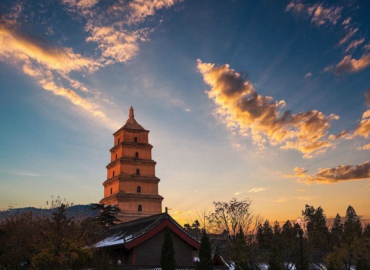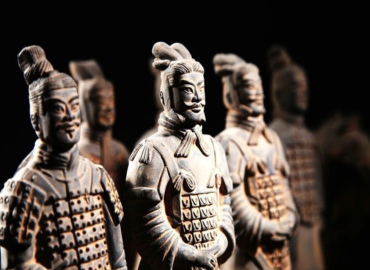Xi'an
It is said, if you want to see 800 years of China's history, visit Beijing; if you want to see 3000 years of China’s history, go to Xi'an. The root of Chinese history and culture being there, Xi'an has so many things to experience, not only the Terracotta Warriors and the City Wall. Our Xi'an tours offer in-depth, unique and interesting ways for you to taste the city fully.
To meet different needs, each customizable Xi'an tour has a special emphasis on different requirements. No matter whether you prefer extensive and in-depth tours or highlights in a nutshell tours, no matter whether most important to you are flexibility and personal interests or best value for money and standardized tours, no matter whether you are a first-time China traveler or whether you live in China, it is easy to find the right Xi'an tour as a start for you.
Recommended tours for Xi'an

- Xi'an
- 2 days
2-day Private Xi'an Essence Tour
Includes all the highlights of Xi'an and discover something under the surface that cannot be Googled with interaction with the locals.
From $289

- Xi'an
- 1 day
1-day Private Xi'an Highlights Tour
Visit the icon of the city - Terra Cotta Warriors, the best-preserved Ancient City Wall in China and stroll in Muslim Street
From $128

- Beijing-Xi'an
- 3 days
3-day Xi'an Highlights Tour from Beijing
Take a high-speed train from Beijing to Xi'an and explore China's most famous historical site – the Terracotta Army along with other attractions.
From $599
Xi'an
Xi'an is the oldest of China's Four Great Ancient Capitals, serving as the capital city of 13 dynasties spreading intermittently across a 1,100-year period from 221 BC. It is often called the birthplace of Chinese civilization.
Xi'an was the eastern terminus of the Silk Road, and played a very important part in Chinese history.
Xi'an is characterized by and is proud of its ancient heritage, such as the world-renowned Terracotta Army. A visit to Xi'an is often at the top of a traveler's to-do list.
Top Things to Do in Xi'an
Xi'an is a melting pot of cultures and religions. It offers countless things to do and see.
- * Witness the most significant archeological excavation of the 20th century — the Terracotta Warriors and Horses, accompanied by an expert guide.
* Stroll or cycle on the ancient City Wall for a nice view of Xi'an city.
* Have a pleasant stroll to taste local snacks and buy souvenirs at the Muslim Quarter.
* Pay a visit to Shaanxi History Museum to discover the culture and history of China.
The Best Times to Visit Xi'an
The best time to visit Xi'an is in spring and autumn when the weather is cool but not too cold. The rainy season occurs from July to September, although there isn't much rain.
Try to avoid the Labor Day holiday (May 1–3) and the National Day holiday (October 1–7) when all tourist sites are crowded with Chinese people.
Attractions in Xi'an
1) Terracotta Amy

The Terracotta Army was constructed to accompany the tomb of China’s First Emperor as an afterlife guard.
The thousands of detailed life-size models represent the army that united China at the end of the Warring States Period (476–221 BC). They were molded in parts, fired, then assembled and painted.
It is considered one of the greatest archaeological sites in the world, and one of the greatest discoveries of the 20th century.
The Terracotta Army figures’ excavation is regarded as one of the greatest discoveries of the 20th century. It had lain underground for more than 2000 years before farmers digging a well in 1974 uncovered what is now considered one of the greatest archaeological sites in the world.
The first part of the Terracotta Army site to be discovered was named Vault One. In 1976, two other vaults were uncovered about 20 meters away, and were named Vault Two and Vault Three.
The tomb is a treasury for the Chinese people and for the whole world. In December 1987, UNESCO selected the Tomb of the First Emperor (including the Terracotta Army Vaults) as a World Cultural Heritage Site.
2) The Ancient City Wall

The first landmark visitors will encounter in Xi'an is the ancient city wall, which surrounds the old city in a large square area. The northern side runs parallel to the railway.
Xi'an was originally a walled city, and even today the wall is considered a landmark dividing the city into the inner part and the outer part. The city wall is massive — tall, long and thick. The South Gate and North Gate are the two main entrances to the inner city. The city itself is neatly arranged along the city wall.
Xi'an City Wall was erected in the 14th century Ming Dynasty, under the regime of Emperor Zhu Yuanzhang.
Interesting to note is that the base of the wall was made of earth, quick lime, and glutinous rice extract, tamped together. It made the wall extremely strong and firm. Later, the wall was totally enclosed with bricks.
3) Big Goose Pagoda

Situated in Da Ci'en (Great Kindness and Grace) Temple, about four kilometers from the urban center, Big Wild Goose Pagoda is one of the most famous Buddhist pagodas in China.
The Pagoda was built in the Tang Dynasty (618-907) for the study of Buddhist scriptures. Although it has been attacked by centuries of weather, war and seismic activity, which destroyed most of the original material of the structure, a pagoda by this name and style still exists on the site.
The Tang regime gave orders to build a chamber for the translation of Buddhist scriptures in an effort to have the then widely renowned Master Xuanzang agree to be the head of the temple.
Xuanzang was a Buddhist monk who traveled to India, translated Sanskrit scriptures and developed theories of consciousness, karma and rebirth that were adopted by some later popular schools of Buddhism.
4) Muslim Street

The main food street area is known as Huimin Street or Muslim Quarter. It's a main street with a few intersecting roads. So the Xi’an Muslim Food Street is the collective name for a number of streets, including Beiyuanmen Street, North Guangji Street, Xiyangshi Street and Dapiyuan Street, and it has become a famous attraction of Xi’an for its profound Muslim cultural atmosphere.
Caution: If you are vegetarian, you may want to reconsider a walk through this street. This is a haven for meat lovers, and there meat all around.
A number of ancient architectural buildings are well-retained on the street, highlighted by Hanguang Gate of the Tang Dynasty (618-907), Xicheng Gate Tower Cluster of the Ming Dynasty (1368-1644), the City God Temple (a Taoist temple) and the Grand Mosque, all of which contrast finely with one another.
Though Muslim Street is regarded as a tourist scenic spot by foreigners, it's actually considered a snack street by the locals, and is an ideal place for locals to kill time during a hot summer.
5) Shaanxi Historical Museum

Located to the northwest of Big Wild Goose Pagoda, in the southern suburbs of Xi'an city, Shaanxi Provincial Museum is a tribute to Shaanxi's glamorous imperial past. The museum building was designed in China's grand and elegant ancient Tang Dynasty (618-907) style.
Shaanxi was an important province in China's imperial past. Xi'an served as the capital of China for 13 dynasties over 1,100 years, from 221 BC to 904 AD. It was the seat of China's first imperial civilization.
Xi'an, a place of great significance in Chinese history, is well-endowed with historical sites and relics. Now most of these relics, once scattered around the region, have found their way to Shaanxi Provincial Museum.
7) Xi'an Great Mosque

The Great Mosque, located at 30 Huajue (Change Feeling) Lane in the center of the city, is the largest and one of the most important Islamic places of worship in China. The Great Mosque was added to the UNESCO Islamic Heritage List in 1985.
It's construction started in 742 AD, the first year of the Tianbao Era of Emperor Xuanrong's reign in the Tang Dynasty, and additions were made during the Song (960-1279), Yuan (1271-1638), Ming (1368-1644), and Qing (1644-1911) dynasties, which makes it an ancient architectural complex representative of many periods of time.
In the Tang dynasty, Islam was introduced to China by the Arabian merchants. Many Muslims settled in China and married Han people. The Great Mosque was constructed at that time to honor the founders of Islam in China. Since then many other mosques have been erected across the county.
8) Mount Hua

Mount Hua is one of the five sacred Taoist mountains in China. It is located 120 kilometers east of Xi'an, about 1½ hours from the city center.
Hua Shan boasts a lot of religious sites: Taoist temples, pavilions, and engraved scriptures are scattered all over the mountain.
Hua Mountain is well-known for its sheer cliffs and plunging ravines. It is known as "the most precipitous mountain under heaven" and is probably the most dangerous mountain in the world frequented by hikers.
There are five peaks that make up the mountain: Cloud Terrace Peak (North Peak, 1614m), Jade Maiden Peak (Middle Peak, 2042m), Sunrise Peak (East Peak, 2100m), Lotus Peak (West Peak, 2083m), and Landing Wild Goose Peak (South Peak, 2155m).